Yosemite Trip Planner

Yosemite Trip Planner | Words and Photos by Julie Boyd
Everything you need to know about planning a trip to Yosemite National Park. This guide combines general information about planning your visit along with our recommendations based on years of visits to this special place.
2023 February Weekend Entry Reservations
If you plan on entering the park over the following weekends during Firefall (February 10-12, 17-19, and 24-26, 2023), you will need to book an entry reservation in advance through Recreation.gov. Reservations are available starting on Friday, January 13, 2023 at 8:00 a.m. PST in which 50% of the available reservations will be released. Two days prior to the specific arrival weekend at 8:00 a.m. PST, the remaining 50% of the available reservations will be released.
Reservations are not required Monday through Thursday or if you have in-park accommodations (hotel, campground) or are arriving via regional public transportation. For more information, please visit the National Park Website here.
Summer reservations will not be required for the 2023 season.
Driving Directions to Yosemite

There are four entrance stations to Yosemite. Here is a breakdown of each entrance in order to help you plan the best driving route to take:
Highway 41 from Fresno (Wawona/Southern Entrance): If you are traveling from Southern California, or if you fly into the Yosemite/Fresno Airport, this will be the best route for you to take. The road is usually open all year (it may close due to wildfires in summer or snowstorms in winter).
Highway 140 from Merced (El Portal/West Entrance): If you are traveling from the Bay Area, this is the best route to take. It is also the easiest (least windy) and most scenic road to drive because it follows the Merced River Canyon into the mountains.
Highway 120 from Manteca (Big Oak Flat/North West Entrance): If you are traveling from Sacramento, this is the quickest route to take into the park. Additionally, if you are heading to Tuolumne Meadows from the Bay Area, this is the fastest route into the high country.
Highway 120 from Lee Vining/Mammoth (Eastern Entrance — Summer Only): This is a great route to take into the park if you are traveling from the East or from the Reno/Tahoe or Mammoth Lakes area. The Eastern Sierra are gorgeous, so if you have the opportunity to explore this area during your trip, take advantage of it!
Getting to Yosemite Without a Car
Many of the airports and nearby towns offer public transportation to Yosemite. Once you are in the park, it is easy to get around to different trailheads and scenic views on the shuttle system. So, if you don’t have a car, or if you are not up for driving on mountain roads, you can still visit! This guide is a great resource which describes how to get to the park from all of the nearby airports. Additional information on all of the public transportation options for Yosemite, can be found here.
Yosemite Road Conditions
What are the road conditions in Yosemite? They change all the time depending on the weather. For up-to-date information, check out the Yosemite National Park Website and Caltrans to help you plan your trip. These are your best resources and will alert you to special conditions, including when tire chains are required during the winter months.
Yosemite National Park Entrance Fee
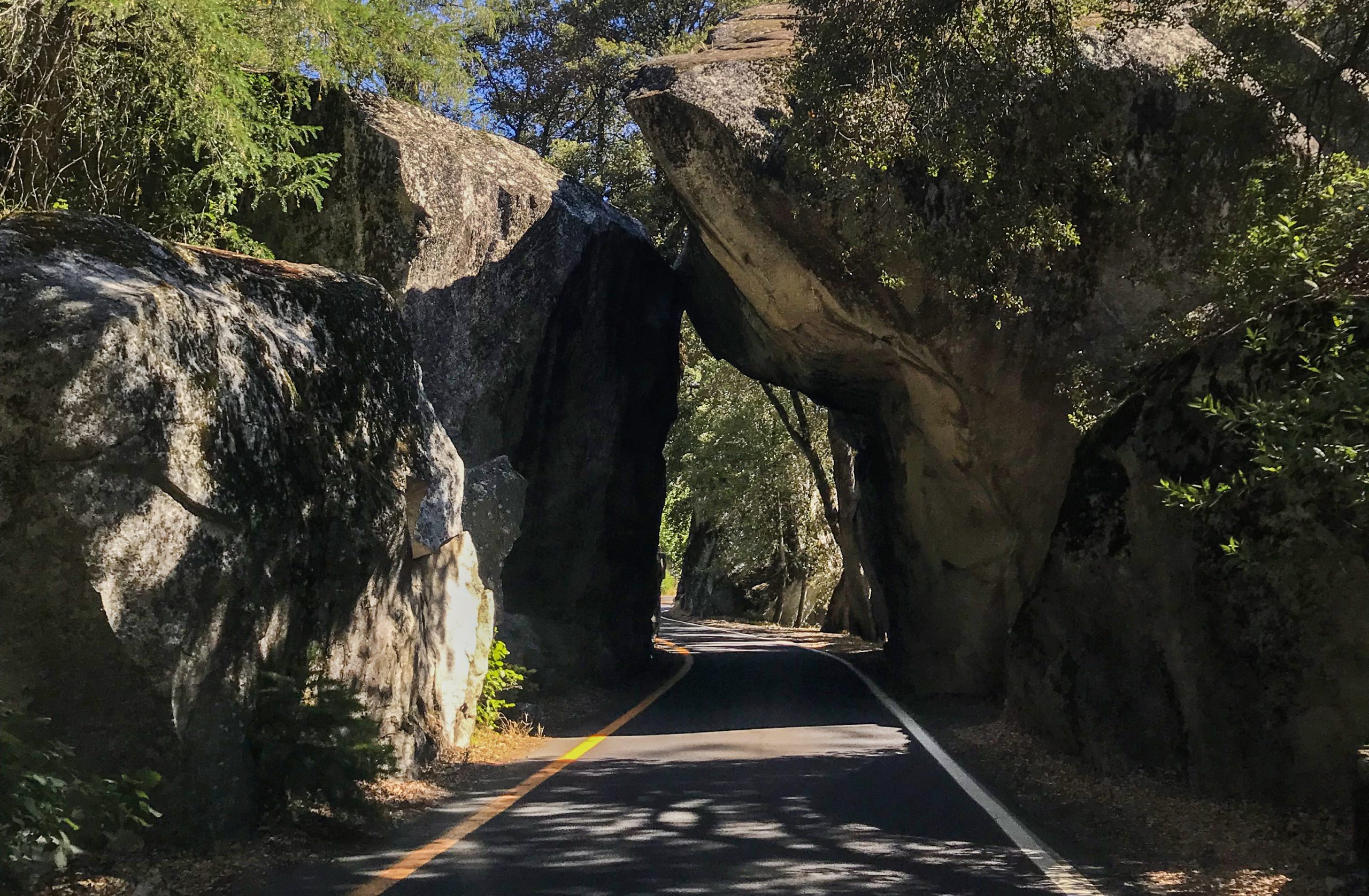
A seven-day pass to Yosemite National Park is $35. You can purchase the pass at the entrance station on the way into the park. If you are just visiting once during the year, and do not plan on visiting any other national parks, this is a great option.
If you plan on visiting Yosemite more than once a year, or if you plan on visiting any other National Parks or federal recreation areas that collect a fee, we strongly recommend purchasing the America the Beautiful Annual Pass for $80. This has saved us tons of money and time over the years. You can purchase the pass at a variety of retailers, or online (we have purchased ours at REI in the past). For more information about the pass, visit the NPS website here.
The Best Time to Visit Yosemite National Park
Yosemite is beautiful any time of the year, but there are definitely pros and cons to certain seasons. We break down each for you to help you plan your trip.
Spring (April — June)

Pros: The waterfalls flow at full force, and wildflowers blanket a carpet of green in the valley. This is the beginning of hiking season, and a good time to hit the trails before the peak of summer.
Cons: April is a shoulder season, so the scenery is not as spectacular if the leaves and meadows haven’t started filling in with greenery and wildflowers yet. Flooding is a possibility. May and June can be crowded. Tioga Pass and Glacier Point roads may not be open yet, limiting the amount of the park you can access. Mosquitoes usually start coming out in June.
Summer (July — September)
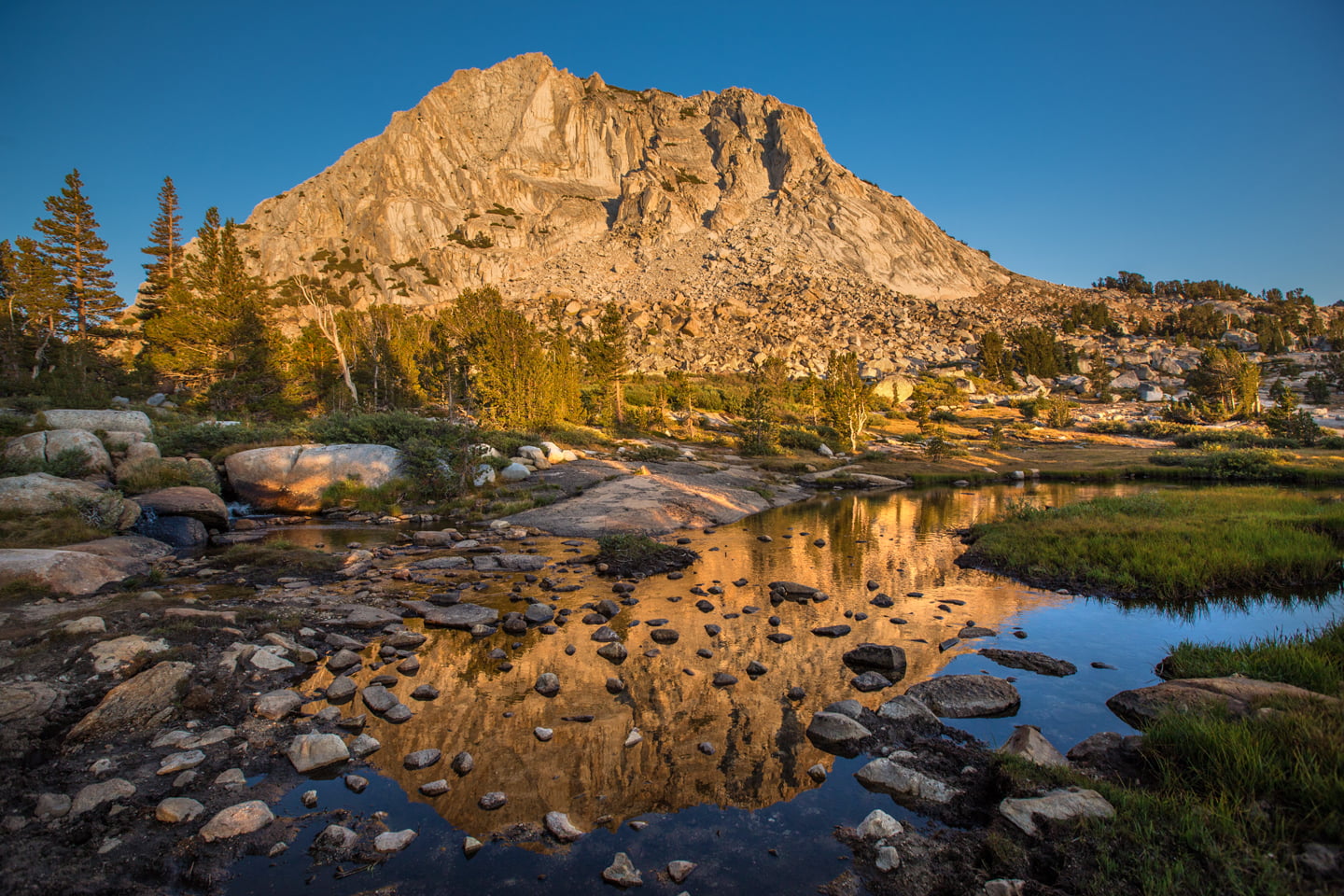
Pros: All trails are open. You can access the high country via Tioga Pass and the Glacier Point Road. Yosemite is truly a hiker’s paradise in summer with endless trails and adventures to explore. This is the time to hit the bigger hikes in the park that may be inaccessible at other points of the year.
Cons: People. There are lots of people. Also, it gets hot and mosquitoes will eat you alive. Depending on the snowpack, waterfalls may begin drying up in early August.
Fall (October — November)
.

Pros: The crowds die down in fall, the temperatures drop, and if you time the leaves changing, you will be rewarded with some of the most breathtaking fall foliage in the Sierra. This is a great time for hiking, even as the daylight shortens, you can enjoy some of the best the park has to offer. Climbing season begins, so if you want to search for an ant-sized Alex Honnold on El Capitan, you want to come in the Fall or Winter.
Cons: The water levels also drop, so many of the famous waterfalls will be dry or a trickle. Early winter storms may limit travel. The Tioga Pass closes to overnight parking in October, so backpacking can be difficult.
Winter ( December — March)
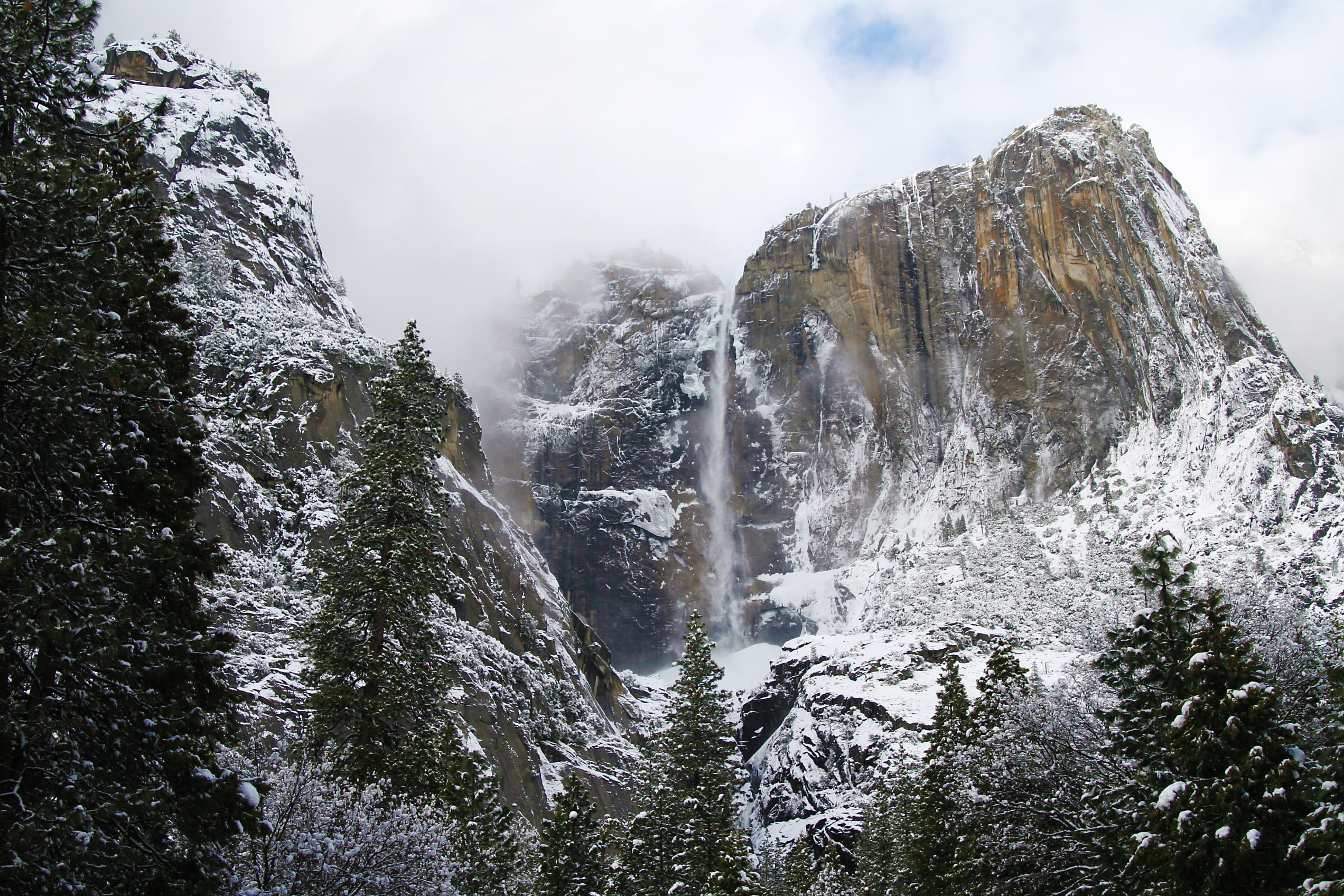
Pros: Yosemite is perhaps the most stunning after a winter storm clears. If you can time your trip right, you will be treated to some of the most jaw-dropping scenery you have ever seen. The crowds continue to be not as bad in winter, and many of the hotels offer packages and discounts if you are able to travel on a weekday. Badger Pass, a small mountain resort, opens for skiing, snowboarding, and snowshoeing.
Cons: Road closures and tire chain restrictions can make winter travel daunting. Parts of the park like The Tioga Pass and Glacier Point will be closed. Many hiking trails will be closed or limited. A big storm could ruin your plans or have you camped out in your hotel room.
The Best Places to Stay in Yosemite
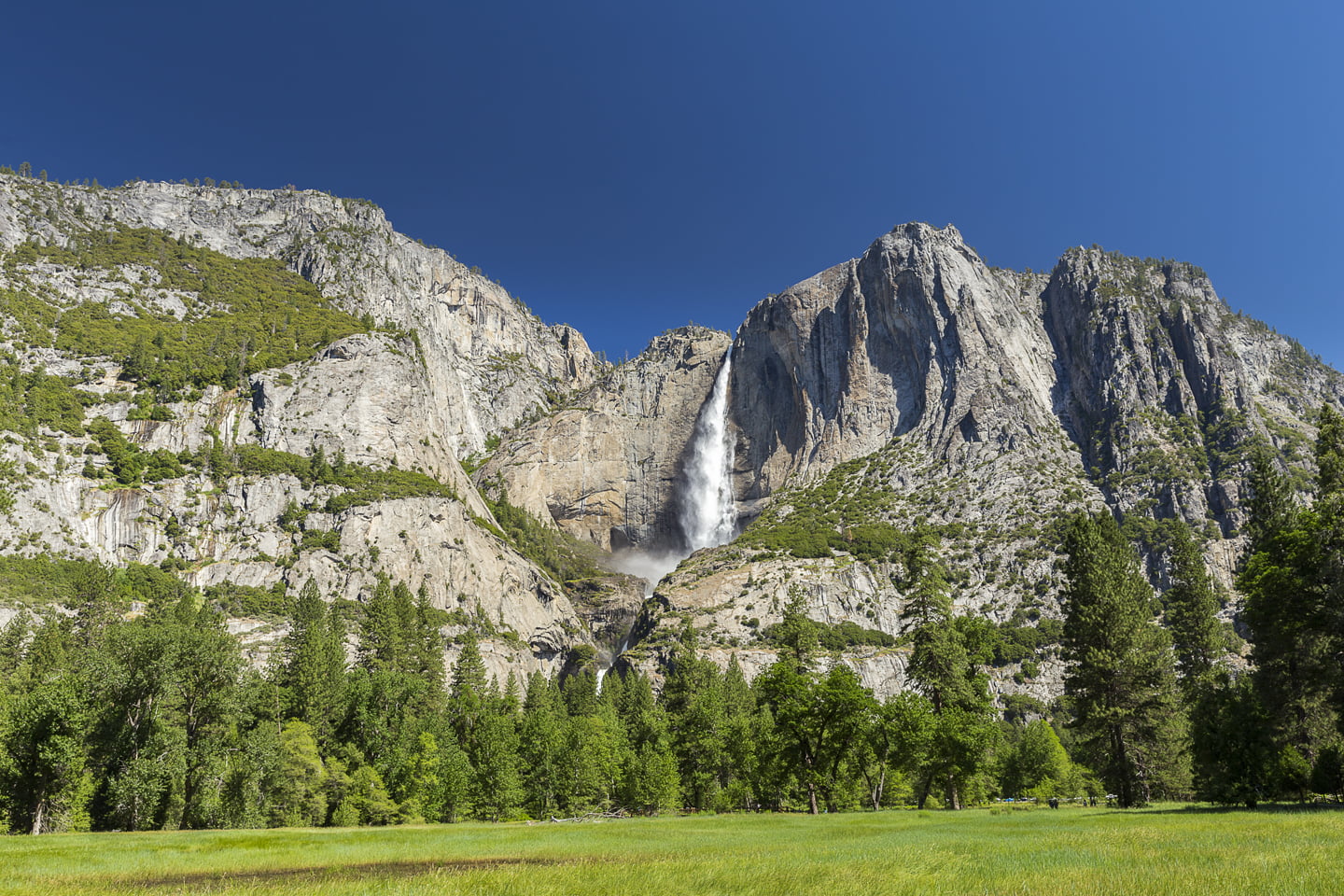
Hotels in Yosemite are expensive, and campsites can be hard to come by if you don’t plan in advance. While there are hotel, campground, and vacation rental options outside of the park, we recommend trying to secure lodging inside if you are able to. This saves travel time each day, and allows you to spend more time exploring the park. Keep in mind that all driving times listed below do not account for weather or entrance station traffic (yet another reason to stay in the park!).
Yosemite Valley Accommodations
We usually try to stay in the Yosemite Valley Lodge due to its central location and price-point. While it is overpriced for the quality of the accommodations and food, it is worth it to us when we wake up to the sound of the falls every morning, and can walk out to fantastic views for sunrise photography.
Other options in the valley include the famous Ahwahnee hotel, or the more modest Curry Village. The latter option has accommodations ranging from hotel rooms to heated tent cabins.
There are four Campgrounds in Yosemite Valley, two of which are open year-round (Upper Pines and Camp 4). All four require reservations May — September, however, the rest of the year Camp 4 allows walk-ups on a first-come, first-serve basis. Keep in mind that you must book reservations online, and when they become available they book up within a matter of minutes. We have heard there are frequent cancellations, so if you are persistent in your search, it is possible to get last-minute bookings. For more information, including booking dates, check out the Yosemite National Park Website.
Accommodations Near Wawona and the South Entrance (Highway 41)
We treated ourselves to a stay at the Tenaya Lodge recently, and really enjoyed the hotel. Located just outside the south entrance of the park, the drawback to staying here was the hour drive on a windy road to the valley.
If you like historic hotels, and don’t mind a bit of a drive into the park, a more modest accommodation in the area is the Wawona Hotel. The hotel is located along Highway 40, and is about a 40-minute drive into the Valley. Be mindful when booking that some rooms have shared restrooms and showers.
El Portal Accommodations (Highway 140)
The Yosemite View Lodge is probably the best option if you are not able to stay inside the park. The hotel is located along the Merced River just outside the Park’s entrance on Highway 140, making it about a 20-minute drive to the valley. The accommodations seem similar to the Yosemite Lodge, at a slightly lower price-point.
Accommodations Near Tuolumne Meadows (Highway 120 East — Summer Only)
There are no traditional hotels in the high county of Yosemite. The Tuolumne Meadows Lodge is the most luxurious of the accommodations in this area, which offers guests heated tent cabins.
There are numerous campgrounds along Highway 120, most of which are first-come, first served. Crane Flat takes reservations, and 50% of the campsites in the Tuolumne Meadows take them as well. For more information visit the Yosemite National Park Website.
Big Oak Flat Accommodations (Highway 120 West)
If you are traveling to Yosemite from the north, you might consider staying at the Rush Creek Lodge or the Evergreen Lodge. The Rush Creek Lodge is a newer hotel located along highway 120, and it is about a 40 minute drive into Yosemite Valley. The Evergreen Lodge is a bit more off-the-beaten-path along the road to Hetch-Hetchy. If you are looking for a quiet place to stay, and don’t mind an hour drive, this is a great option. We stayed here for a night after hiking to Cathedral Lakes for sunset, and really enjoyed the lodge. As an added bonus, the food was the best we have had in the park and surrounding areas so far!
The Hodgdon Meadow Campground is the closest to the Park Entrance if you are traveling from Northern California. Reservations are required April-October, and the campground remains open all year. For more information check out the Yosemite National Park Website.
Vacation Rentals in Yosemite
Within the park, there are three areas of private property that rent out houses and apartments. If you are traveling with a big group, this might be a great option to save on accommodations and prepare your own meals.
Foresta is a small community located off of the Big Oak Flat Road (Highway 120). One of the enticing attributes of this community is that you can sneak a peek of Half Dome and El Capitan from parts of the town. You can see their listings on 4Yosemite.
Yosemite West is located near the turnoff to Glacier Point Road, and The Redwoods are located in the southern area of the park near Wawona. Both are great jumping-off points to explore the southern end of the park, and they are a short drive into the valley.
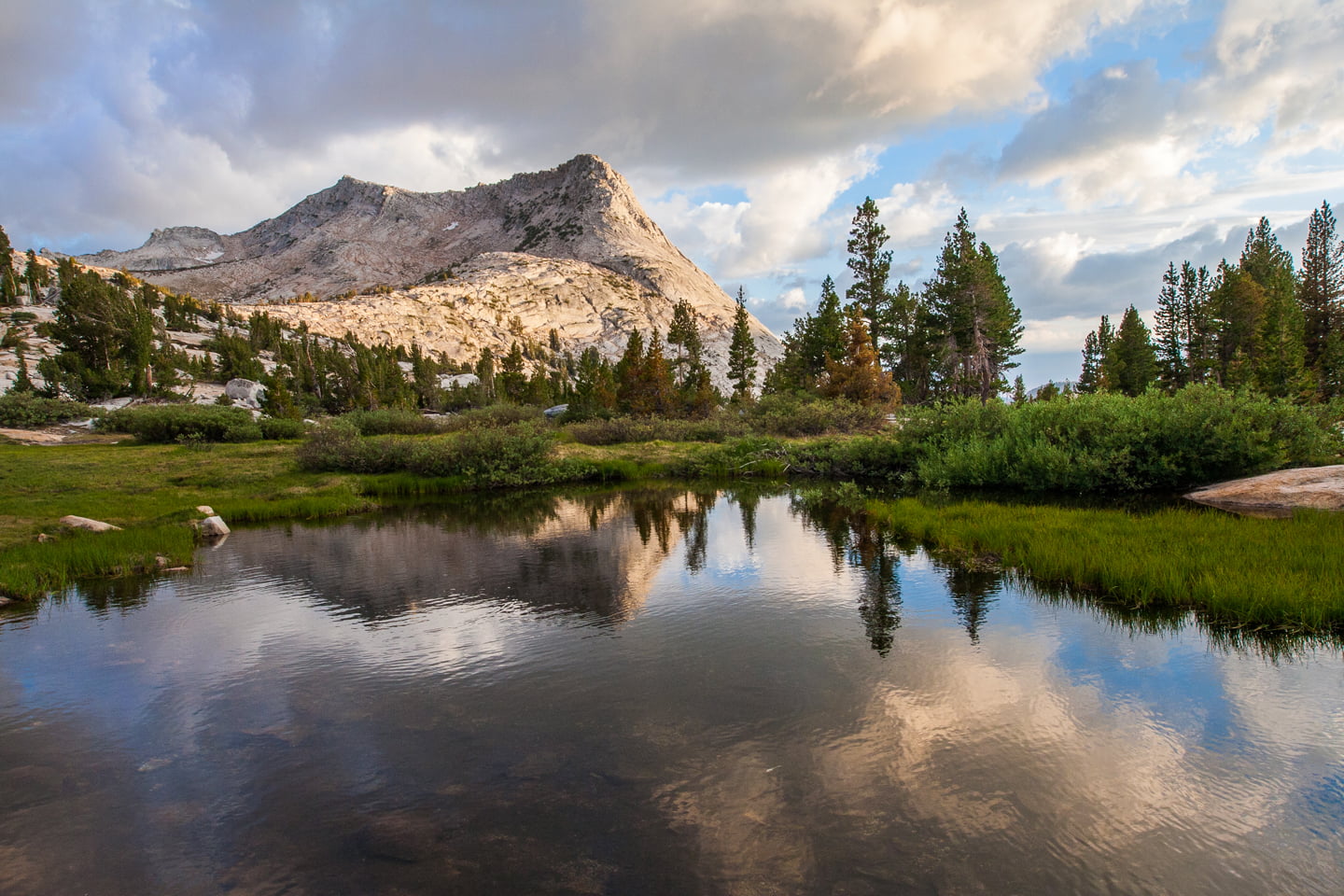
Where to eat in Yosemite
In our experience, the dining options in Yosemite Valley have let us down. Most places are crowded, and the food is uninspiring and overpriced. In addition, there was a infamous food poisoning incident in early 2020 that still has us questioning the food safety practices of their current concessionaire. If you can, bring your own food.
If you can’t bring your own food, there are several dining options in Yosemite Valley ranging from casual, cafeteria-style eateries like the Base Camp Eatery at the Yosemite Valley Lodge, to fine dining experiences like that at The Ahwahnee Dining Room. You can read more about these options, and make reservations (which are recommended for the restaurants the offer table service) here.
If you are having Starbucks withdrawals on your trip, The Yosemite Valley Lodge recently opened one near the main lobby.
If you want to grab cold beer on tap, the Mountain Room Bar at the Yosemite Valley Lodge is a great place to kick up your feet after a long day of hiking. Their fire-pits are especially popular in the cooler evenings.
If you are willing to drive, or are staying outside of the valley we recommend the Whoa Nellie Deli in Lee Vining, and The Tavern at the Evergreen Lodge.
Where to Buy Groceries in Yosemite
The Village Store (Located in Yosemite Village) is the largest market in the park. They have a wide variety of groceries and snacks, as well as fresh meat and produce available for purchase. In addition, they carry basic gear that you may have forgotten to pack, and a collection of souvenirs that you may not have realized you needed.
There are also several smaller shops located throughout the park. More information, including hours and seasonal closures, can be found here.
Yosemite Hiking Guide

If you are planning your first trip to Yosemite, the hiking choices can be overwhelming. We put this guide together to help you pick the best hikes based on your ability. Be sure to click through each link for more detailed trail descriptions and pictures.
Favorite Easy Hikes in Yosemite
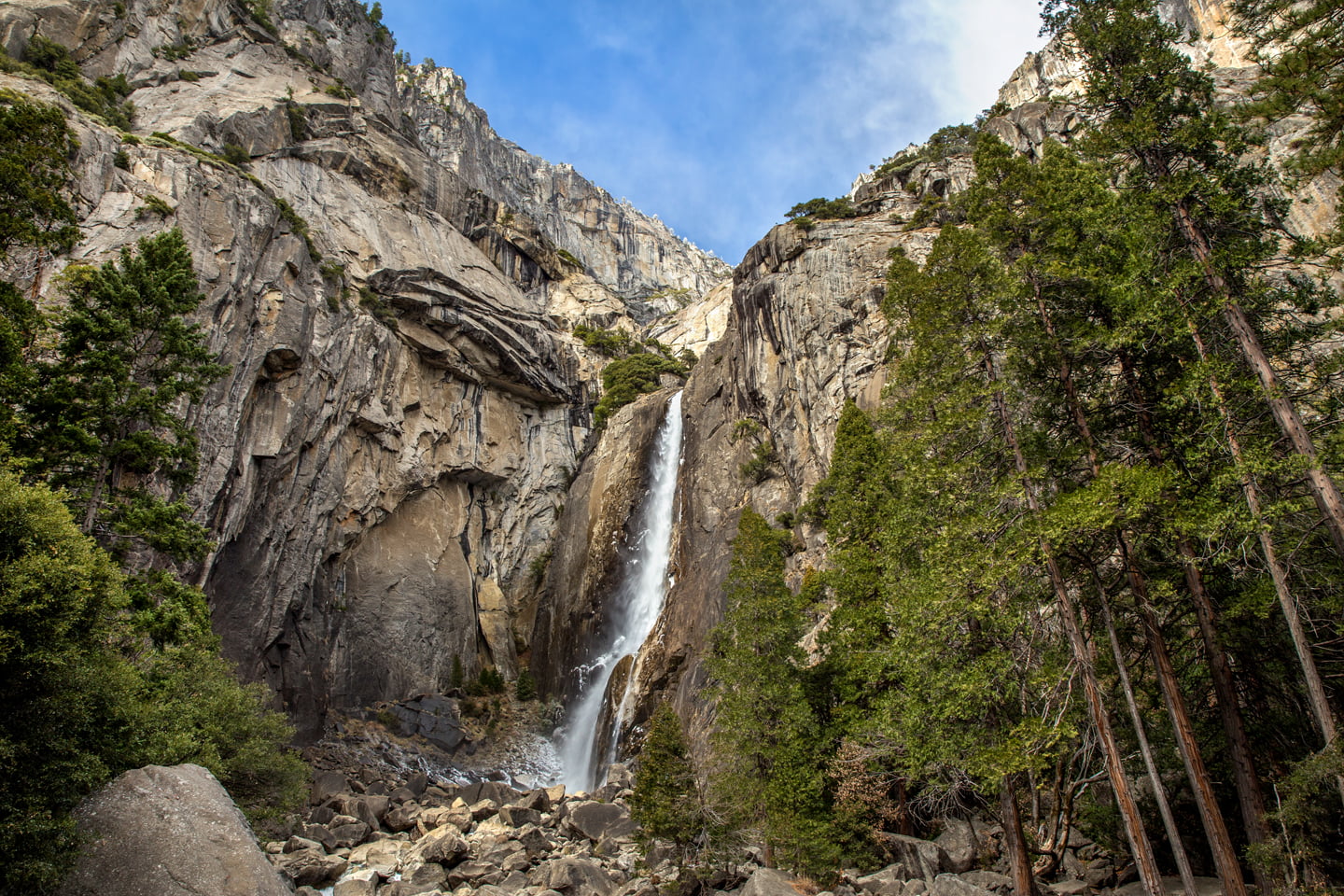
Vernal Falls Footbridge (2 mi): If you aren’t up for hiking the entire Mist Trail, you can gain a peek of Vernal falls by taking this short, but slightly steep hike to a bridge below the falls.
Lower Yosemite Falls (1 mi): This accessible and popular trail takes travelers to the bottom of Yosemite Falls. Definitely get here early to avoid crowds.
Cook’s Meadow Loop (2 mi): A nice, mostly flat trail that takes you through several meadows and along the Merced River with beautiful views of Yosemite Falls and Half Dome.
May Lake (3 mi): This short hike off Tioga Road travels to a beautiful alpine lake and one of Yosemite’s five High Sierra Camps. A higher starting elevation makes this an easy-moderate, summer hike.
Mirror Lake (2-5 mi): One of the most popular, short hikes in Yosemite Valley. Mileage will vary based on which route you take and whether or not you want to do the whole loop. The lake, which is a wide section of Tenaya Creek is a great place to visit in spring and early summer when there is water
Favorite Moderate Hikes in Yosemite

Upper Gaylor Lakes (3 mi): A short hike accessible from the Tioga Road. Rated moderate because the beginning takes you up a steep slope that is quite tiring when combined with the higher starting elevation.
Top of Lower Yosemite Falls (3 mi): This trail is short, but the 1,000 ft gain in the first mile will give you a pretty good workout. Once at Columbia Rock, you will be rewarded with unique views of Half Dome, and just around the corner the top of Lower Yosemite Falls is a sight not to be missed.
Taft Point and Sentinel Dome Loop (10 mi): Some of the best views in Yosemite are found on this trail that takes you to several vistas along the valley’s south rim. While the distance may seem long, there isn’t much elevation gain. You can also shave distance off by doing each point as an out-and-back from the parking lot.
Wapama Falls (5.2 mi): Located in the Hetch Hetchy section of Yosemite, this easy-moderate hike is a seasonal treat in spring and early summer. The falls rival many of their more well-known neighbors in Yosemite Valley. If you’re going to do one hike in Hetch Hetchy, make it this one.
Favorite Difficult Hikes in Yosemite

Cathedral Lakes (11 mi): A high altitude trek to two alpine lakes that lie in the shadow of a craggy granite spire. This hike isn’t especially strenuous, but starts at a higher elevation (near 9,000 ft.) which can make it tougher if you are starting your day at sea-level.
Vernal and Nevada Falls (9.7 mi): One of our favorite hikes in the Yosemite Valley. This loop takes you up the aptly named Mist Trail alongside two waterfalls, and down the famous John Muir Trail with beautiful views the whole way.
North Dome (9 mi): A hike that is about the destination and not so much the journey. This trek through the woods ends on the edge of the valley rim with a fresh look of Half Dome face-on.
Favorite Strenuous Hikes in Yosemite

Upper Yosemite Falls and Yosemite Point (8.5 mi): A leg-burning climb up the valley’s northern rim. The views will fuel you though, and the reward at the top makes this trek a worthy adventure.
Four Mile Trail to Glacier Point (10.5 mi): Spectacular views of Yosemite Falls make this tough trek to Glacier Point worth your time. One of the preeminent hikes in Yosemite National Park.
Stanford Point (10.6 mi): A relentless climb from Tunnel View up to the valley rim takes you to a bird’s-eye view of the popular vista below.
Cloud’s Rest (14.5 mi): A high country adventure to a granite vista behind Half Dome. Most hikers who have made the journey say that this is the ultimate view of Yosemite Valley.
Half Dome (16 mi): Making it to the top of Half Dome is on almost every hiker’s bucket list. This strenuous, and dangerous, hike takes you from the valley floor, past two of Yosemite’s famous waterfalls, and up the backside of the park’s most famous landmark. You will need courage and a permit to go on this adventure, so make sure you have both before you hit the trail. More information about the Half Dome permit system can be found here.
Other Yosemite Adventures
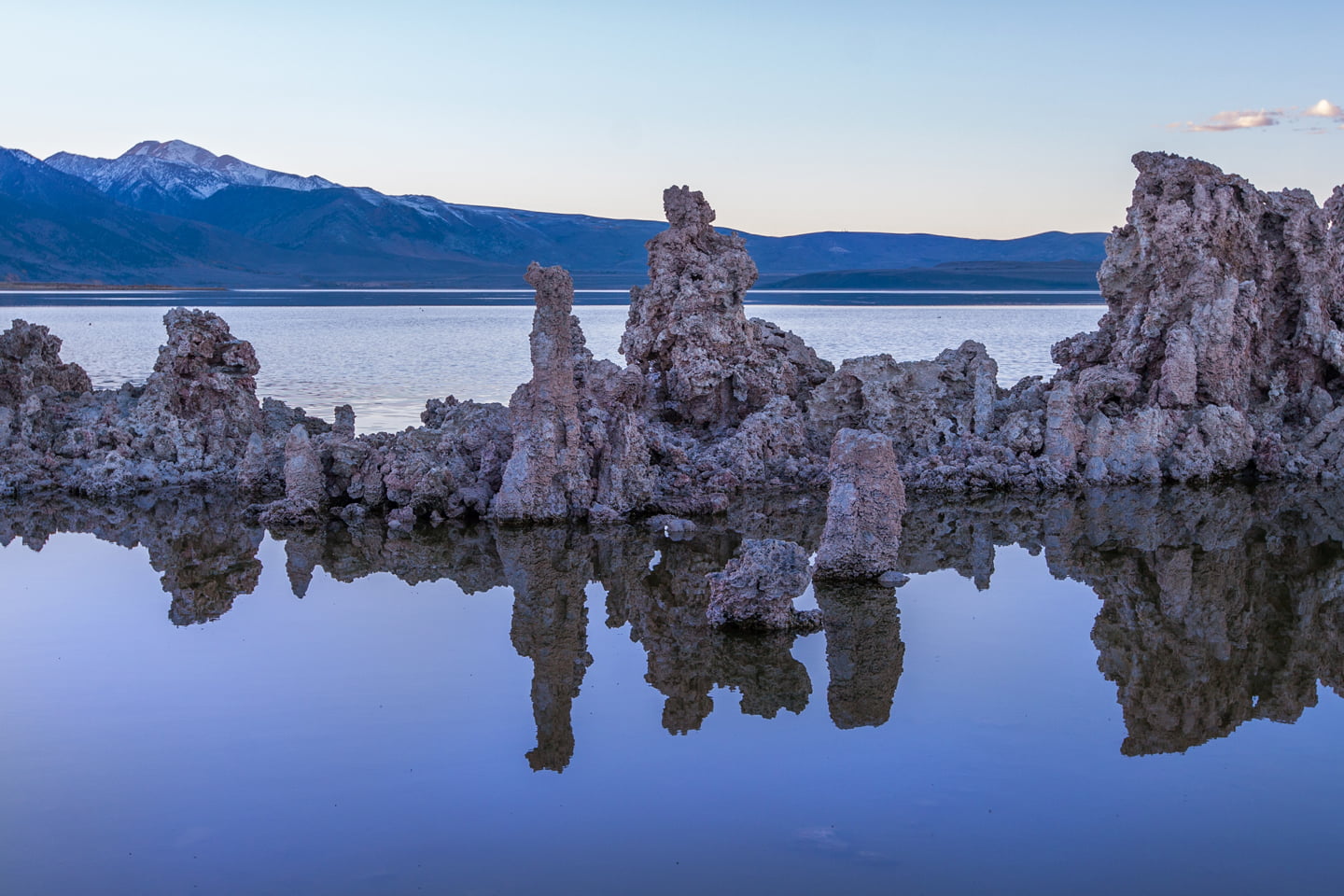
Visit the Giant Sequoia Trees in the Mariposa Grove
If you have never seen a giant sequoia in person, don’t miss this opportunity! The scale of these ancient trees is something no photograph could ever capture. You just have to stand below them in person and see for yourself. This area has no shortage of hikes to explore: You can do a 7-mile loop through the entire grove, or a .3-mile Big Trees Loop.
Take a Scenic Drive over the Tioga Pass
This one of our favorite drives in California. The views of the Yosemite high country are stunning: pine forests, green meadows, alpine lakes, and craggy peaks. Additionally, the Eastern Sierra is worth visiting if you have the time. I wouldn’t miss Mono Lake, or a quick drive through the June Lake Loop (a must-visit for fall colors!).
Snowshoe to Dewey Point in Winter
This is one of the best things to do when visiting Yosemite in the winter. You can drive, or take a shuttle up to the Badger Pass Ski Area, and rent snowshoes. The trail to Dewey Point is well-marked, and traveled, and the views from the vista give you a unique perspective of El Capitan from head-on.
Backpack through the High Sierra Camps
This is a great introduction to backpacking as you don’t have to worry about bringing a heavy pack filled with supplies for overnight camping. The High Sierra Camps are a series of alpine retreats that include tent cabins and a dining hall. So, you can pack your day pack, and travel between them at your leisure. Julie and her family visited three of the camps several years ago, and still relish in the memories of their trip adventures.
Photographing Yosemite
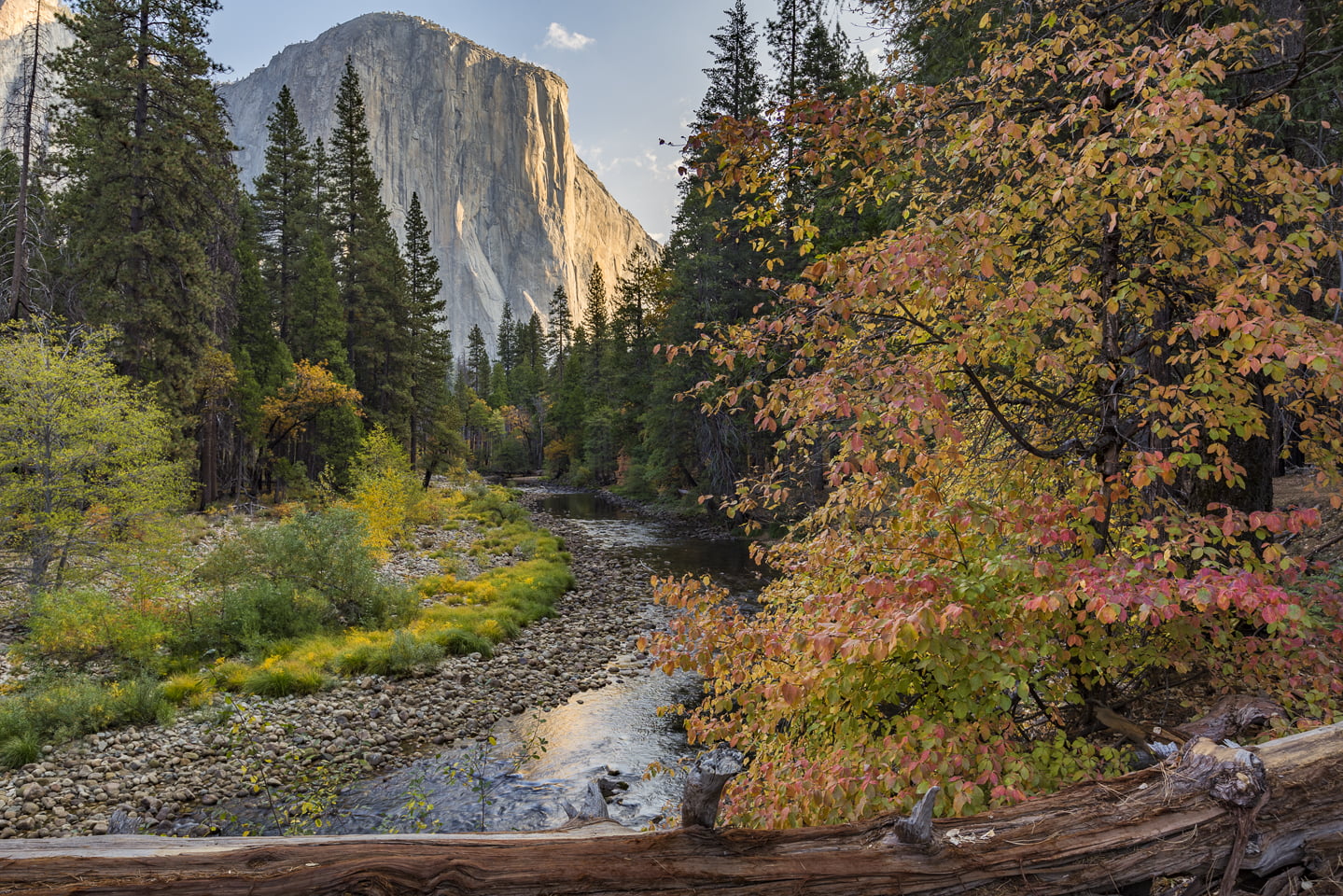
Yosemite has some of the most iconic locations for landscape photography. Since the valley is on the Western side of the Sierra, most of the park looks best at sunset. We recommend Tunnel View, Valley View, and Glacier Point for watching the last light of the day illuminate the granite rocks.
Sunrises can be stunning in these locations too, but usually only if there are clouds present to pick up color. Morning light illuminates Yosemite Falls the best about an hour after sunrise. There are also some beautiful locations along the Merced River that catch the early rays of the sun. We recommend walking around the Valley Loop Trail and exploring!
How to Avoid Crowds in Yosemite
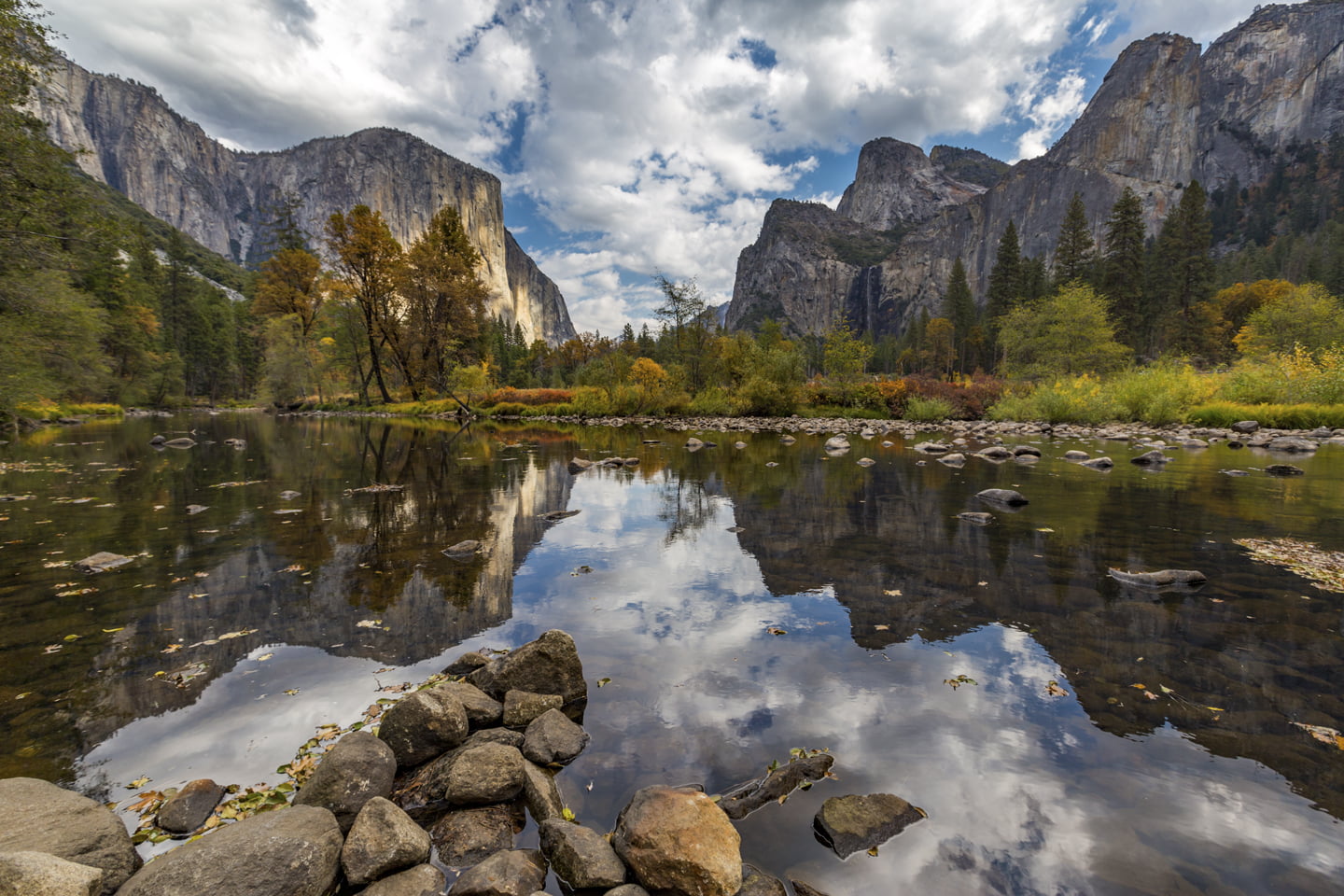
1. Get up early! People start arriving and hitting the trails around 8:00 a.m. Get a head-start by setting your alarm.
2. Visit October — April to avoid the summer crowds. If you can visit on a weekday that’s even better!
3. Explore lesser-known areas. Tuolumne Meadows is less crowded than Yosemite Valley in the summer and has arguably more beautiful scenery. The Hetch-Hetchy Valley is also a hidden gem that not many people frequent.
4. If you want to see the giant sequoia trees, visit the Tuolumne Grove or the Merced Grove instead of the Mariposa Grove. While it is bigger, and more accessible, the Mariposa Grove is much more crowded.
5. Avoid going in February during the Firefall phenomenon. Social and print media have highly publicized this event, and now so many people flock to see it that the park becomes extremely crowded for two weeks in February. While it is beautiful to witness first-hand, the road closures and access restrictions make it an unpleasant time to visit.

What to see if you only have one day in Yosemite?
If you only have one day to explore Yosemite, here are the best roadside views not to miss:
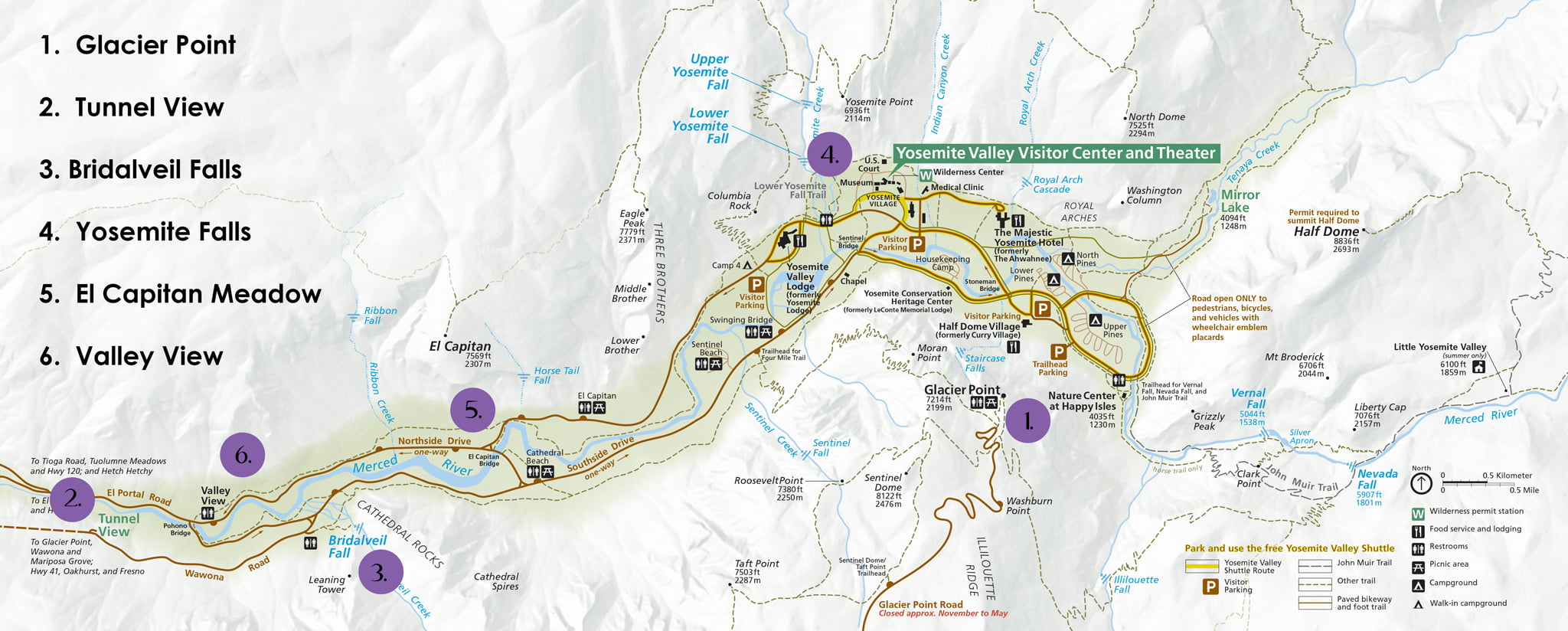
More Planning Resources
We highly recommend purchasing a trail map if you are doing any sort of extensive hiking. We frequently use the Day Hikes of Yosemite National Park Map Guide that was put together by Jake from Hike 734. His insights as a hiker, and passion for the outdoors make this a reliable and insightful resource.
When Julie first started pursuing landscape photography, she purchased Michael Frye’s The Photographer’s Guide to Yosemite. It has been a great resource over the years as it offers seasonal tips about lighting conditions and photography locations.
Yosemite Packing List
Clothing: Be sure to dress in layers as the weather in the mountains can change quickly. Moisture-wicking material is important for any physical activities you may do, and it’s a good idea to carry a rain jacket, even in summer. You will want to be prepared for hot days in summer, followed by cooler evenings. In the Spring and Fall temperatures vary (usually mild/warm days followed by cold nights), so check the weather ahead of time and bring a variety of layers. In the winter, be sure to bring extra layers to protect against snow.
Footwear: Make sure you have comfortable footwear with a good grip. We recommend the Aku Alterra hiking boots, or a pair of trail runners like these Hoka One One Challengers. Don’t forget that wool socks are important too for wicking moisture and preventing blisters. We love the Darn Tough and Smartwool brands. In winter, a pair of micro-spikes are essential for hiking and can even be necessary on sidewalks in the valley.
Hiking Backpack: If you are planning on hiking, you will need a day-pack to carry water and snacks. Brian loves this one from Gregory because it distributes the weight well, and Julie uses this Osprey pack because it works well for her photography gear.
Hiking Poles help with stability and prevent soreness and injury. We love our Black Diamond Trail Ergo Cork Trekking Poles.
Sun Protection: The sun is harsh in the mountains, so make sure you are prepared with sunscreen, SPF chapstick, and a hat.
Bug Protection: In the spring and early summer you may encounter mosquitoes. Be sure to have some sort of repellent like picadarin or deet on hand, and you might also consider a face net.
A First-Aid Kit: You can never be too prepared when visiting the outdoors. We like this travel-size kit so that we can put it in our day pack on hikes. We have definitely used it a few times, and were glad to have it handy.
Hydration: Make sure you bring plenty of water on any hikes you plan to do in Yosemite. We recently switched to the Platypus bladders and love them. For longer hikes, we often bring along a couple of extra Nalgene bottles filled with water or an electrolyte mix.
Snacks: Some of our favorite high-energy snacks include GU (Salted Caramel is a favorite) and Cliff Shot Blocks (We love Mountain Berry and Ginger Ale).
Be sure to check out our posts: Summer Hiking Gear and Photography Gear for more tips on what to pack for a trip to Yosemite.
Yosemite Frequently Asked Questions
Are dogs allowed in Yosemite?
Yes, but with some very important exceptions. Dogs must stay in established areas, paved paths, and are not allowed on any hiking trails or walk-in campgrounds. For those traveling with their furry friend, consider places like the Yosemite Valley Loop, Lower Yosemite Falls, Glacier Point and similar options. Be sure to store their food in bear boxes as you would your own food and check this page for additional information.
I have limited mobility, are there options for me?
Yes! So much of Yosemite can be enjoyed just be driving through the park and stopping at iconic viewpoints. You can utilize our guide for visiting the park in one day above as a reference point as all of these stops offer quintessential Yosemite views and are accessible. And don’t limit your visit to Yosemite Valley! If you are coming to the park during the summer, be sure to drive up to the High Country for more stunning scenery. Additional information can be accessed through the park’s extensive accessibility guide.
Can I travel to Yosemite with my RV?
Absolutely! Be sure to take it slow, and use pullouts for faster traffic to pass, as many of the park roads are at a lower speed to begin with and some are especially windy. There are 10 Yosemite campgrounds that allow RV parking, and reservations are strongly encouraged — particularly during the summer peak season. Keep in mind that roadside camping within the National Park is illegal and you must stay in an established campground. Additional information, including road restrictions for RVs can be found here.
Is there cell service and WiFi in the park?
Yes and no. We have found that the best cell service tends to be in the established areas of the park such as Yosemite Village, but it is by no means robust. WiFi is available for guests at the Yosemite Valley Lodge, The Ahwahnee Hotel, Curry Village and the Wawona Hotel, and can also be found at Degnan’s Kitchen. In our experience the speeds are pretty abysmal, so don’t plan to stream any movies or have that Zoom call you were hoping for. For more information on carrier details, check this link.
Can I ride my bike or rent one in Yosemite?
Yes! There are a dozen miles worth of paved trails in Yosemite and riding through the Valley is a popular choice for families during the summer. Be sure to follow all the rules of the road and remember that off trail biking is not allowed. If you don’t have a bike, they can be rented from Yosemite Valley Lodge or Curry Village. More information including rental rates can be found here.
Does Yosemite offer tours if I want to be led by a guide?
They do! While we haven’t personally taken a tour of the park since we’re locals, we have heard positive feedback. Tours are great for those who are looking to see the park, learn the history, and not have to worry about transportation. You can find information on Yosemite tour options here.
Can you plan our trip for us?
We hope that you have found our comprehensive guide to visiting Yosemite useful in your planning! If you would like a personalized itinerary, feel free to send us a message and we would be happy to discuss some options with you!
Your Yosemite photos are stunning, do you offer prints?
Yes! Julie sells her landscape prints which come in a variety of sizes and prices. For more information, click the link here or send us a message!
Extending Your Trip to Yosemite
There are not shortage of beautiful places to visit in California. Here are some of our favorites that you could easily visit if you wanted to extend your trip to Yosemite.
Visit Redwood National and State Parks
The Ultimate California Road Trip
Road Trip to the Shasta-Cascade Region



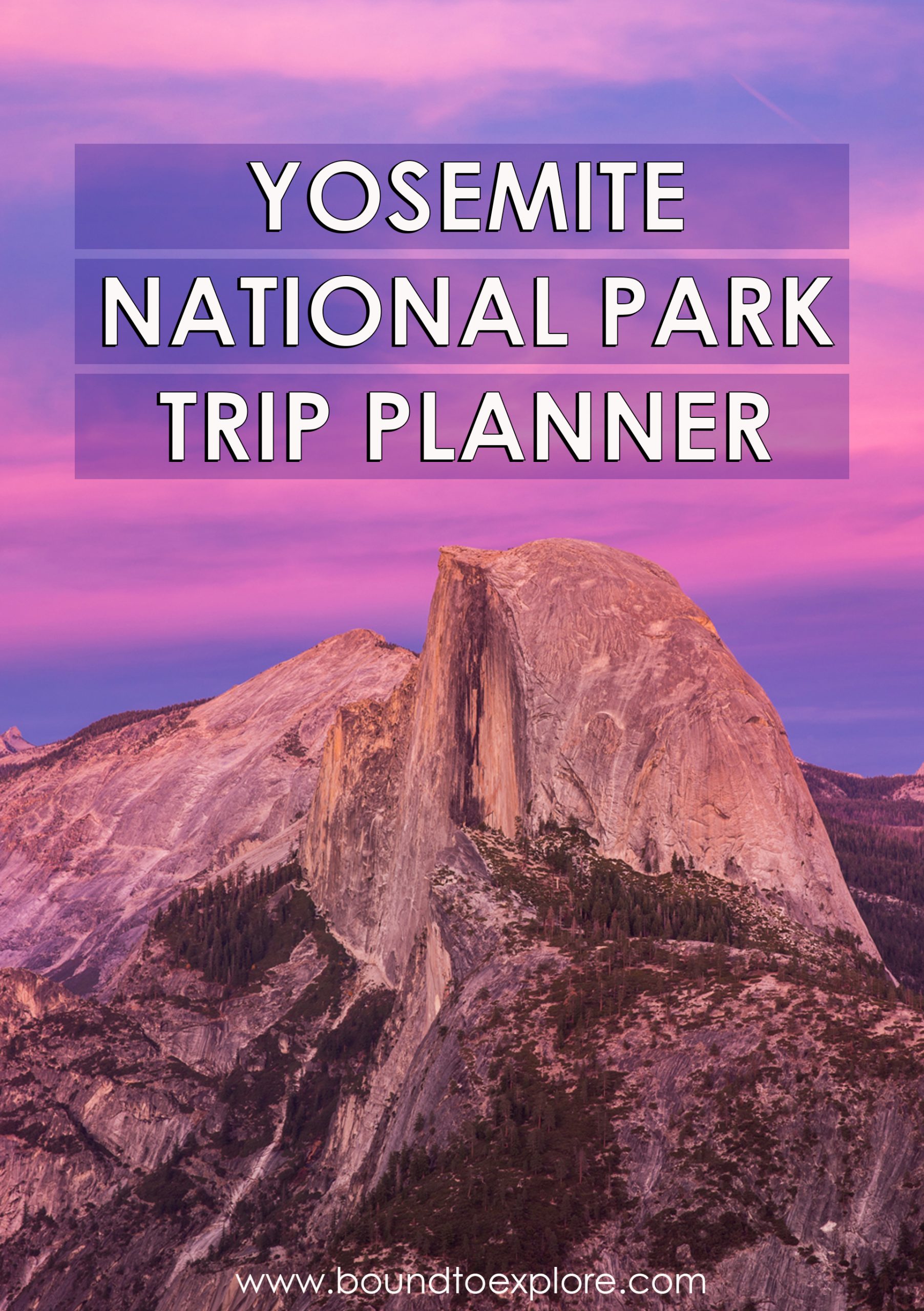
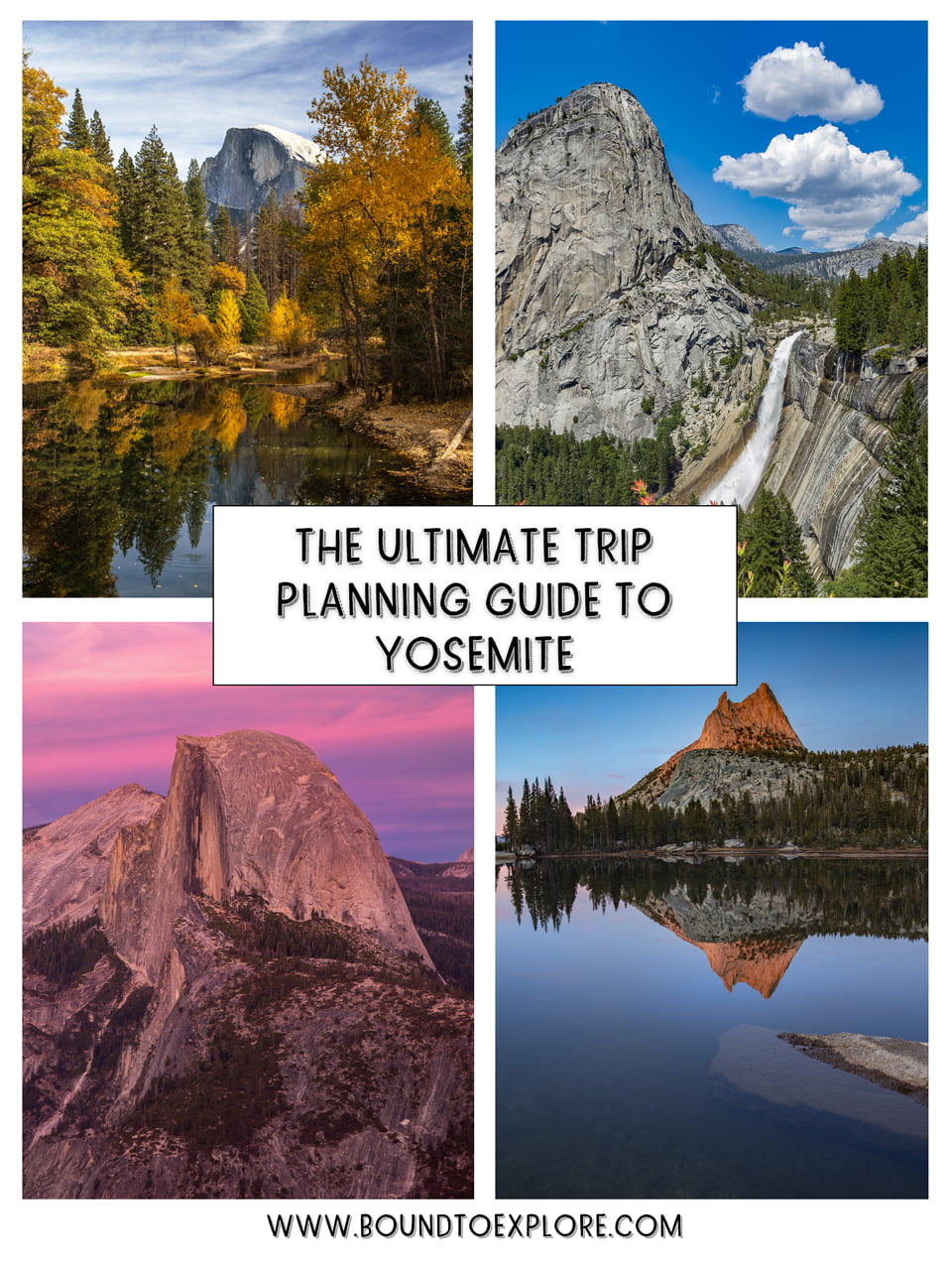
Thanks a lot for this article, for all the recommandations. The pictures are amazing.
I really hope I can visit your beautiful country one day 🙂
We’re so glad you found it valuable, Agathe! Hopefully you get a chance to come visit soon! 🙂
Wow! That first sunset photo just took my breath away! And the Valley View is also spectacular! But more important, thank you for the incredibly insightful information provided in this post and the packing list is especially useful!
Thanks Michelle! We’re glad you found the information useful and hope you get a chance to visit Yosemite in the near future.
Love this! It’s so detailed and your pics are gorgeous! As a frequent visitor to Yosemite I would also recommend the Hodgdon Meadow Campground. It’s half way between the valley and Tioga Pass, so much less crowded, very quiet and still in the park. Also, a few miles past Mono Lake is a very cool ghost town, Bodie, CA.
Thanks Carrie! We haven’t made it to Bodie quite yet, but it’s on our list and we’ll be sure to add it once we do. Hope you get a chance to visit Yosemite again soon!
We have been thinking of Yosemite for some time now. With air travel being a bit sketchy, we are looking at future road trips and have moved Yosemite up on the list. This post is super helpful in planning! Thank you!
You’re welcome, Jenn! Yosemite is honestly one of our favorite places to visit and a road trip is the perfect way to enjoy the park. We hope you get a chance to make it there very soon!
I have always wanted to go to this park! looks so incredible! great pics BTW
Thanks Maria! I hope you get a chance to visit Yosemite sometime in the near future!
Wow, thanks for all the tips! I love your seasonal breakdown tips. There are definitely pros and cons to the various seasons. Even though we haven’t been to Yosemite, I agree with you about staying inside the Park. Last summer we went to Yellowstone and it would have given us extra hours to explore if we had booked a room inside the park. Keeping our fingerscrossed we get to Yosemite soon!!!
You’re welcome! We hope you get a chance to visit Yosemite soon, it’s definitely worthy of a road trip! When we visited Yellowstone in 2017, we stayed at Headwaters at Flagg Ranch and were outside of the park as well. It made our days longer with the added time driving into and out of the park. In the future, we would stay at a hotel or camp somewhere in the park, and find that strategy works well for Yosemite too!
I want to visit Yosemite so badly! Every photo I see of the park is so beautiful and hiking around there would be amazing. Can’t wait to visit one day and see Half Dome in person 🙂
It’s definitely a place that you have to experience! One of our all-time favorite destinations and we’re fortunate to live close enough to keep coming back time and agin. Hope you get a chance to visit!
We have long wanted to visit Yosemite but have never made it. Your photos definitely show all of the beauty that there is there.
Thanks Michelle! I hope you get to visit Yosemite sometime soon!
I haven’t been to Yosemite yet and your pictures make me want to book a trip tomorrow! Incredible. It looks like it would be great to visit any time of the year — but which time of the year is your favorite?
Thanks Pam! It’s so hard to pick a favorite season in Yosemite because each one offers something different. Spring and Fall are probably the top choices for us, if we had to pick. Spring means the waterfalls are flowing and the crowds are still not at their peak. Fall brings beautiful colors and less people, plus the days are cooler and you can typically still access the high country. Whatever you choose, Yosemite will be special!
This is such a valuable resource! Typically, I don’t travel to national parks because I don’t even know how to start with planning. But, Yosemite has been really high on my list, I talk about going with my parents all of the time because it’s one of their dreams. This is the first resource I’ve come across that is well organized and easy on the eyes visually. I’ll be saving this for next summer! Thank you!
Thanks so much Stephanie, we’re glad you found it useful! Hope you make it out to Yosemite next year and do let us know if you have any questions. It’s one of our all-time favorite places and you’ll have a great time when you go!
Yosemite has been on our list for years but we have yet to visit. I know that I couldn’t handle the cold, and it always seems to be too expensive during the summer. Maybe I can make it happen in fall or spring! Regardless, I will be saving your post to help in my planning! Thanks so much!
Spring and Fall are both great times to visit Yosemite! We recommend May since the waterfalls are flowing and most of the hiking in the park is accessible. Hope you get a chance to visit soon!
Yosemite is so beautiful! I miss living just a few hours away and being able to visit in the spring when the wildflowers are blooming and the waterfalls are flowing!
It really is! We love that we can drive out to the park and spend the day and return home and Spring is one of our favorite times to visit!
Since I’m not driving, it’s always a bit difficult exploring places like these in the United States. However, I’ve visited Yosemite on a day trip, and it was very impressive. On the other hand, it was also one of the most expensive day trips I ever took — although it was far from a private tour. Nope, a coach full of crazy Europeans who are not driving.
I still love to look at my pictures of those imposing rocks — and, obviously, I’ve enjoyed your pix, too 😀
Thanks for sharing your experience visiting Yosemite, Renata! Glad to hear you were able to enjoy the park without having your own vehicle and that you enjoyed our photos!